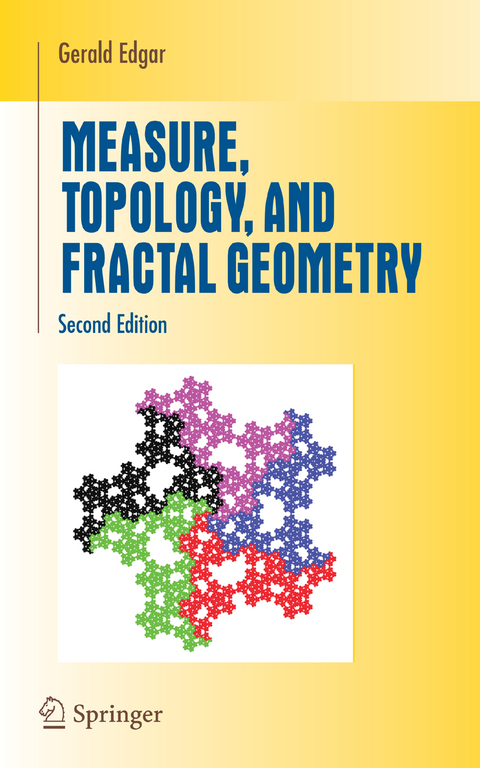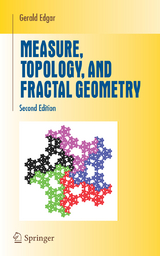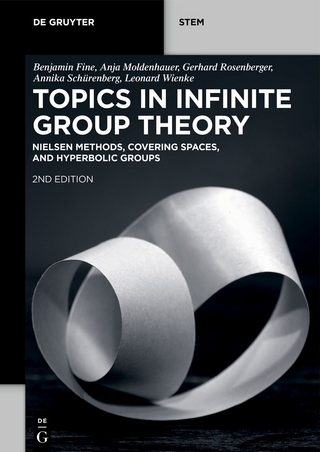Measure, Topology, and Fractal Geometry
Seiten
2007
|
2nd ed. 2008
Springer-Verlag New York Inc.
978-0-387-74748-4 (ISBN)
Springer-Verlag New York Inc.
978-0-387-74748-4 (ISBN)
This is essentially an advanced undergraduate textbook about the mathematics of fractal geometry. It is based on a course given to talented high-school students at Ohio University in 1988 and contains plenty of examples, exercises, and good illustrations of fractals.
From reviews of the first edition:
"In the world of mathematics, the 1980's might well be described as the "decade of the fractal". Starting with Benoit Mandelbrot's remarkable text The Fractal Geometry of Nature, there has been a deluge of books, articles and television programmes about the beautiful mathematical objects, drawn by computers using recursive or iterative algorithms, which Mandelbrot christened fractals. Gerald Edgar's book is a significant addition to this deluge. Based on a course given to talented high- school students at Ohio University in 1988, it is, in fact, an advanced undergraduate textbook about the mathematics of fractal geometry, treating such topics as metric spaces, measure theory, dimension theory, and even some algebraic topology...the book also contains many good illustrations of fractals (including 16 color plates)."
Mathematics Teaching
"The book can be recommended to students who seriously want to know about the mathematical foundation of fractals, and to lecturers who want to illustrate a standard course in metric topology by interesting examples."
Christoph Bandt, Mathematical Reviews
"...not only intended to fit mathematics students who wish to learn fractal geometry from its beginning but also students in computer science who are interested in the subject. Especially, for the last students the author gives the required topics from metric topology and measure theory on an elementary level. The book is written in a very clear style and contains a lot of exercises which should be worked out."
H.Haase, Zentralblatt
About the second edition: Changes throughout the text, taking into account developments in the subject matter since 1990; Major changes in chapter 6. Since 1990 it has become clear that there are two notions of dimension that play complementary roles, so the emphasis on Hausdorff dimension will be replaced by the two: Hausdorff dimension and packing dimension. 6.1 will remain, but a new section on packing dimension will follow it, then the old sections 6.2--6.4 will be re-written to show both types of dimension; Substantial change in chapter 7: new examples along with recent developments; Sections rewritten to be made clearer and more focused.
From reviews of the first edition:
"In the world of mathematics, the 1980's might well be described as the "decade of the fractal". Starting with Benoit Mandelbrot's remarkable text The Fractal Geometry of Nature, there has been a deluge of books, articles and television programmes about the beautiful mathematical objects, drawn by computers using recursive or iterative algorithms, which Mandelbrot christened fractals. Gerald Edgar's book is a significant addition to this deluge. Based on a course given to talented high- school students at Ohio University in 1988, it is, in fact, an advanced undergraduate textbook about the mathematics of fractal geometry, treating such topics as metric spaces, measure theory, dimension theory, and even some algebraic topology...the book also contains many good illustrations of fractals (including 16 color plates)."
Mathematics Teaching
"The book can be recommended to students who seriously want to know about the mathematical foundation of fractals, and to lecturers who want to illustrate a standard course in metric topology by interesting examples."
Christoph Bandt, Mathematical Reviews
"...not only intended to fit mathematics students who wish to learn fractal geometry from its beginning but also students in computer science who are interested in the subject. Especially, for the last students the author gives the required topics from metric topology and measure theory on an elementary level. The book is written in a very clear style and contains a lot of exercises which should be worked out."
H.Haase, Zentralblatt
About the second edition: Changes throughout the text, taking into account developments in the subject matter since 1990; Major changes in chapter 6. Since 1990 it has become clear that there are two notions of dimension that play complementary roles, so the emphasis on Hausdorff dimension will be replaced by the two: Hausdorff dimension and packing dimension. 6.1 will remain, but a new section on packing dimension will follow it, then the old sections 6.2--6.4 will be re-written to show both types of dimension; Substantial change in chapter 7: new examples along with recent developments; Sections rewritten to be made clearer and more focused.
Fractal Examples.- Metric Topology.- Topological Dimension.- Self-Similarity.- Measure Theory.- Fractal Dimension.- Additional Topics.
| Reihe/Serie | Undergraduate Texts in Mathematics |
|---|---|
| Zusatzinfo | 20 Illustrations, color; 149 Illustrations, black and white; XVI, 272 p. 169 illus., 20 illus. in color. |
| Verlagsort | New York, NY |
| Sprache | englisch |
| Maße | 155 x 235 mm |
| Themenwelt | Mathematik / Informatik ► Mathematik ► Geometrie / Topologie |
| Mathematik / Informatik ► Mathematik ► Wahrscheinlichkeit / Kombinatorik | |
| ISBN-10 | 0-387-74748-6 / 0387747486 |
| ISBN-13 | 978-0-387-74748-4 / 9780387747484 |
| Zustand | Neuware |
| Haben Sie eine Frage zum Produkt? |
Mehr entdecken
aus dem Bereich
aus dem Bereich
Gekrümmte Kurven und Flächen
Buch | Softcover (2024)
De Gruyter (Verlag)
CHF 76,90
Nielsen Methods, Covering Spaces, and Hyperbolic Groups
Buch | Softcover (2024)
De Gruyter (Verlag)
CHF 153,90




